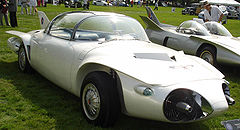General Motors Firebird: Difference between revisions
m Reverting possible vandalism by 24.112.3.233 to version by Davewho2. False positive? Report it. Thanks, ClueBot. (558302) (Bot) |
|||
| Line 16: | Line 16: | ||
== Firebird III == |
== Firebird III == |
||
Hi |
|||
[[Image:FirebirdIII.jpg|thumb|240px|Firebird III]] |
|||
The third design, the Firebird III, was built in 1958 and first shown at Motorama in 1959. It is another extravagant prototype with titanium skin, and no fewer than seven short wings and tail fins that were tested extensively in a wind tunnel. It is a two-seater powered by a {{convert|225|hp|abbr=on}} Whirlfire GT-305 gas turbine engine, and a two cylinder {{convert|10|hp|abbr=on}} gasoline engine to run all the accessories. Its exterior design features a double bubble canopy, and more technical advancements to make it more practical, such as [[cruise control]], [[anti-lock braking system|anti-lock brakes]], and [[air conditioning]]. It also featured "space-age" innovations, such as special [[air brake (aircraft)|air drag brakes]], like those found on aircraft, which emerged from flat panels in the bodywork of the car to slow it from high speeds, an "ultra-sonic" key which signaled the doors to open, and an automated guidance system to avoid accidents and "no hold" steering. The steering was controlled by a joystick positioned between the two seats. This gave the car a more futuristic feel and simulated the experience of flying a plane. |
|||
==Motorama theme (1956)== |
==Motorama theme (1956)== |
||
Revision as of 20:52, 4 March 2010
- For the latter General Motors-produced vehicle, see Pontiac Firebird.
The General Motors Firebird is a series of three concept cars designed by Harley Earl, and built by General Motors for the 1953, 1956 and 1959 Motorama auto shows. They were very much inspired by innovations in fighter aircraft design at the time. None of the designs were intended for production, but instead were to showcase the extremes in technology and design that General Motors was able to achieve. The cars were recently placed on display at the Henry Ford Museum in Dearborn, Michigan, and still make regular car show appearances.

History
General Motors had done research on feasibility of gas turbine engines in cars as early as the 1930s. It wasn't until the early 1950s that they began building an actual engine, with Emmett Conklin leading the project.
Firebird I

By 1953, the research team had produced the Firebird XP-21, later referred to as the Firebird I, which was essentially a jet airplane on wheels. It was the first gas turbine powered car tested in the United States. The design is entirely impractical, with a bubble topped canopy over a single seat cockpit, a bullet shaped fuselage made entirely of fiberglass, short wings, and a vertical tail fin. It has a 370 hp (280 kW) Whirlfire Turbo Power gas turbine engine, which has two speeds, and expels jet exhaust at some 1,250 °F (677 °C). The entire weight of the car is 2,500 lb (1,134 kg).
At first, Conklin was the only person qualified to drive it, and he tested it up to 100 mph (160 km/h), but upon shifting into second gear the tires lost traction under the extreme engine torque and he immediately slowed down for fear of crashing. The car was later test driven at the Indianapolis Speedway by race car driver Maury Rose. The car was never actually intended to test the power or speed potential of the gas turbine, but merely the practical feasibility of its use. The braking system differs from standard drum systems, in that the drums are on the outside of the wheels to facilitate fast cooling, and the wings actually have aircraft style flaps for slowing from high speed.
Firebird II

The second prototype, the Firebird II in 1956, was a more practical design: a four-seat, family car. It is a low and wide design with a large dual air intakes in the front, a high bubble canopy top, and a vertical tail fin. Its exterior bodywork was made entirely of titanium. The engine output was 200 hp (150 kW), and to solve the exhaust heat problem it was fed through a regenerative system, which allowed the entire engine to operate at nearly 1,000 °F (538 °C) cooler, and also power the accessories. Another innovation on the car was the first use of four wheel disc brakes, with a fully independent suspension, as well as a sophisticated guidance system which was intended to be used with "the highway of the future", where an electrical wire would be embedded into a roadway to send signals that would help guide future cars and avoid accidents.
Firebird III
Hi
Motorama theme (1956)
The 1956 motorama projected movie projecting a future contrasted with the present; in the present (1956), a nuclear family of hot and perspiring convertible occupants are attempting to travel to the beach - but they are stuck, imobile, in an insufferable freeway jam. In a flashforward to the future, they are cruising at high speed in air conditioned comfort along an automated freeway (with no other vehicles to be seen) in their turbine-powered Firebird. The concept (now over fifty years old) was that this future was not unreasonably remote, and would be provided by General Motors, yet is consistent with current projections (2008) for future automotive travel using electronic vehicle control and improved highway infrastructure.
See also
- Chrysler Turbine Car, a consumer prototype gas turbine design by the Chrysler Corporation.
